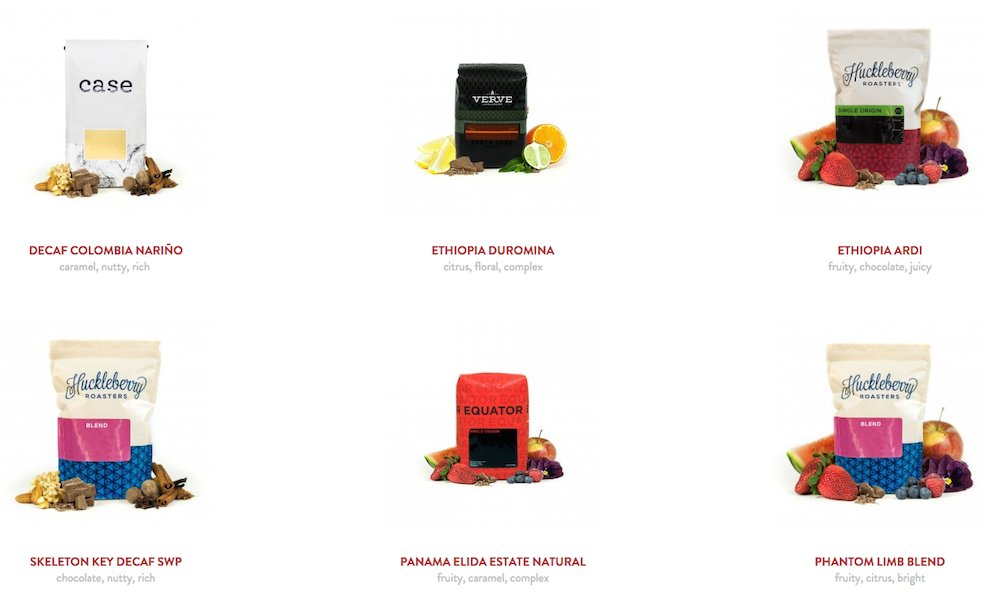Caffeine is the world's most popular drug, and coffee is the world's most popular caffeine-delivery system. Just the scent of a rich, chocolatey cup can electrify your body.
But not all coffee is created equal. Light versus dark roasts; blends versus single-origins; pour-over brews versus the break-room drip machine. It's complicated. Piecing together the right combination can be the difference between morning bliss and a bitter mess.
Connor Riley wants to find the perfect roast for you. He's not out to genetically engineer some holy-grail of coffee beans, though—he just wants to connect you to a cup of coffee that matches your tastes, precisely.
That's part of why Connor and his co-founder, Sam Meis, started MistoBox. It's a coffee subscription service that sends people a sampling of blends from all over the world. You tell them what you like, and MistoBox will use that information to tailor a box of coffees compatible to your preferences. Based on a schedule you set, that caffeinated care package arrives at your doorstep with something new to try.

It takes a huge inventory to pull off made-to-order deliveries. At any time, MistoBox offers more than 500 different coffees from around 35 different roasters. But for Connor, quality trumps quantity. "Our goal isn't to have as many coffee roasters as we possibly can," Connor says. "Our goal is to work with the absolute best coffee roasters."
Sam and Connor dreamed up MistoBox in late 2011, as classmates at the University of Arizona. Since then, they've launched their personalized coffee subscriptions, secured funding on Shark Tank, and hired four employees (including a "director of coffee"—i.e. the coolest job title ever).
The MistoBox crew is small, yet energetic. They have to be—there's a lot to get done. Keeping up with an ever-changing inventory while maintaining high-quality recommendations is enough to keep a dedicated team busy. But what happens if you only have one person to handle the job? There isn't enough coffee in the world to keep someone awake 24/7.
That's where Zapier comes in. Connor uses it to connect and automate the apps that MistoBox relies on. It's like having an extra employee who never sleeps.
We spoke with Connor about how MistoBox uses Zapier to manage inventory, improve their coffee recommendations and fill out their small team.
Managing Inventory

From the first time you visit its site, MistoBox introduces you to a worldwide selection of rare java. Blossoming coffee lovers can choose to get their fix delivered as a tailored subscription, or as a one-time purchase from the online shop.
And maintaining that supply is no easy task—the availability of each blend changes on a daily basis, and roasters needed a way to update their selection on the site.
"Coffee is a crop. A lot of the roasters we work with have single-origin coffees that are coming from a single region, or even a single farm," Connor says. "Once that coffee's gone, it's gone. So there are constantly new coffees coming in, and coffees that are being sold out."
In the early days, Connor handled all of the inventory updates via email. Roasters would periodically send him PDF attachments that covered which coffees were new, and which ones were sold out. Then copy-paste nightmare started. Connor would find the old blend in Magento, the e-commerce system used to manage their online store. He'd delete the sold-out option, and manually enter the new product name, price, description, and tasting notes.

Remember: that's with a constantly changing inventory of 500-plus coffees. Data-entry was cheating Connor out of his time.
"It was extremely unorganized and sporadic. Updates rolled in over the course of a week, and it was distracting to handle them one-by-one," he says. "Also, roasters would forget to tell us that coffees were sold out, or that new coffees had come in. Before you knew it, we'd have ten orders for coffees that were no longer available."
Nobody likes to let their customers down. And when your first note to someone says "Whoops, sorry, we're actually sold out of that one," it doesn't lay a strong foundation for an ongoing relationship.
"We knew that this was one of the biggest bottlenecks that we had in terms of time, accuracy of orders, and overall customer experience," Connor says. "Once I discovered that Zapier could connect Google Sheets directly to Magento, it was like heaven. It saved us precious time."
Connor's fix for the traffic jam in his supply chain was to give roasters the power to update products themselves. With two Zaps, everything could be automated. That meant no more irritating emails, and fewer apologies to annoyed customers.
The first Zap connects Google Forms to Google Sheets. Each roaster has their own single-page Google Form where they can enter information about new coffees that they're offering. Once they submit a new product, Zapier automatically adds it to a row in Connor's inventory spreadsheet.
Send new data from one Google Sheets spreadsheet to another Google Sheets spreadsheet
The second Zap triggers on the first. Whenever Zapier sees a new row (i.e. a new coffee) in the Google spreadsheet, it automatically creates a new product in Magento based on the information that the roasters provided.
Create products in Magento from new rows in Google Sheets
These Zaps put power in the hands of MistoBox's trusted team of roasters, and takes the burden of manually updating products off of Connor's shoulders. Everything happens in the background, and Connor set it up without writing a lick of code.
"If we didn't have Zapier to create this solution for us, anything that we would have done for this would have had to be developed by our engineer, Nick, which would have taken countless hours of time," Connor says. "Instead, he could be doing things that are more valuable."
The process for deleting sold-out products is still manual. But Connor streamlined the operation by connecting Google Sheets to Asana, a collaborative task-management app.
MistoBox's roasters have access to the Google spreadsheet that lists the current inventory in detail. Once a coffee sells out, the roaster can mark it as unavailable. That change triggers Connor's Zap, which automatically creates an Asana task, reminding the team to remove that coffee from their Magento store.
Now, whoever's online can act on that Asana task, remove the sold-out product from the shop, and avoid upsetting their customers.
Improving Retention

Now that there's coffee in the database, Connor's team needs to figure out how to deliver it based on each customer's tastes. They get an idea of what you might like in the simplest way possible: they ask.
When you sign up for MistoBox, you start by filling out a questionnaire. First, you pick your favorite kind of roast: light, bold, or somewhere in between. Next up you choose among different types of coffee, such as single-origin, blends, and espresso blends. From there you select the flavor profiles—like citrus, chocolate, floral, or nutty—and provide an estimate of how many cups you brew per week.
From there, MistoBox's algorithm checks your stated preferences against their currently available coffees, and matches you up with the most compatible option. Simple enough, right?
"The problem is, the coffees that people tell you they like aren't always what they actually like," Connor says. "There's no set definition of what's a light roast, what's a medium roast, or what's a dark roast."
Maybe you think you love rich, bold roasts, when a fruitier blend would actually sit better with your palette. That's ok—MistoBox can hook you up with either option. But sussing out the ideal flavor is harder than picking light or dark.
"Rather than trying to explain what they didn't like, a lot of times people will just cancel their subscription," Connor says. "They'll say 'I told you guys what I like, and you didn't make it happen.'"
Recommendations are tough. But if you can offer up super-relevant suggestions to your customers, it's a boon for your product's retention. (Let's just say there's a reason for Pinterest to put engineering effort behind related Pins, and for Spotify to amp up their discovery features.)
The thing that's different about coffee, though, is that people are already hooked. "The only reason somebody is going to stop drinking coffee is if there's some health-related implication. Other than that, they're going to keep drinking coffee," Connor says. "So we know that every time somebody cancels, it's typically something that we're doing wrong, and they're going to be getting their coffee from somebody else."
MistoBox has options that fit every type of coffee drinker. Picking the right coffee for this specific person is the problem. Right now, Connor's goal is to nail the flavor profile by the second or third shipment. And the only way he can pull that off is to uncover what his customers didn't like about a blend.
Every MistoBox customer has a coffee history tab, which lists each coffee that they've received, when it was sent, and an optional rating. Coffees are rated on a scale of 1 to 5, and there's an extra text box where people can leave notes, too.

Connor wanted to tap into the comments that customers leave on their coffee shipments, and use that data to improve their recommendations. If a customer loved the caramel-tinged Guatemalan blend that she received—and rated it five stars—great; no action needed. If she hated it, though, and gave it a one-star rating, Connor wanted to follow up and find out why that particular coffee was underwhelming.
"That's the most important thing to make the retention work: If we can find out exactly the type of coffee somebody likes, within the first two to three shipments, the lifetime value of that customer is exponentially greater," Connor says. "If we can get you to the third shipment, we're good to go."
Ratings are stored in MistoBox's database. But because Connor uses Desk, a help desk app, to communicate with customers, he wanted to pull every conversation into that platform.
Zapier comes in here again. Connor pieced together a Zap that watches for new coffee reviews across customers, via a webhook (a data-delivery tool that provides apps with information). When the Zap picks up on a rating, it automatically creates a new case for that customer in Desk, complete with their email address, rating, and any notes they left about the coffee.
Now, Connor can see every review that rolls in. If it's positive, he knows they're on the right track. If it's negative—i.e. the customer rated the coffee two-stars or less—he reaches out directly.
"If somebody says they don't like a coffee, we can go in, make some tweaks to their preferences, and let them know we made changes," Connor says. "But if somebody give us a bad review, and doesn't tell us why, then we can reach out and say 'Hey, you didn't really like this coffee. Can you explain a little bit more so we can avoid sending you coffees like this in the future?'"
Connor relies on Desk to get the full picture about each customer, and uses other Zaps to keep each person's profile up-to-date, too. For example, whenever a customer changes their subscription status, a webhook from analytics platform Mixpanel tells Zapier to create a case in Desk that automatically updates that customer's plan level.
With that extra bit of info, Connor can triage his support efforts, and help customers who are just getting started.
"If somebody subscribed within the last 30 days, we'll get back to them within an hour every single time," Connor says. "That's one of my favorite things about our webhook-to-Desk Zaps, that we can prioritize customer cases based off of subscription status, and then based off of whether or not they're brand new to MistoBox."
Because the MistoBox team was looking for very customized data, most of their Mixpanel triggers were custom-built with Zapier's Developer Platform, a tool that anyone can use to connect an app to Zapier.
How to Recreate MistoBox's Zapier Workflow

You and the MistoBox team might use different tools to keep your business on-track. No worries: Zapier supports more than 550 different apps, so odds are you can still snag their time-saving workflow.
Here are some creative ways that you can get the same results with different apps.
Track form entries in a Google Spreadsheet
Connor and Sam use a Google Form to collect information about new coffees from their suppliers around the globe. You could use a form app to log orders, reservations, feature requests or feedback, and track it all in a spreadsheet.
Collect new Typeform responses as rows on Google Sheets
Add new Wufoo entries to a Google Sheets spreadsheet
Add rows to Google Sheets spreadsheets from Ninja Forms form submissions
Save FormKeep submissions to a Google Sheets spreadsheet
Create rows in Google Sheets for new Gravity Forms submissions
Create new products in your e-commerce shop using a form
Sam and Connor are working on an international scale, which means their coffee roasters may be prepping new products while the MistoBox team sleeps. To make sure their inventory is always up-to-date, they push new coffees straight from Google Sheets to their online shop.
If you're collaborating with a team, working with custom products, or just don't like the hassle of giving vendors access to your e-commerce backend, these Zaps will help you update your storefront faster.
Create to-dos for your team using a Google spreadsheet
Once a specific type of coffee sells out, the MistoBox team uses Zapier to automatically create a task in Asana based on a change in their inventory spreadsheet. This reminds them to remove that blend from their shop.
If you have a spreadsheet-based workflow, try using one of these Zaps to create to-dos based on changes to your data.
Create Trello cards from new rows on Google Sheets
Turn Google Sheets spreadsheet rows into OmniFocus tasks
Create help desk tickets based on on-site ratings
Connor set up a Zap that creates new help-desk tickets whenever a MistoBox customer reviews their shipment. That means he can respond to questions, comments and concerns individually—especially if they're from MistoBox newbies.
You can set up a similar system with one of these Zaps: Connect a webhook to your site's ratings or reviews system, and we'll automatically create a help desk ticket, so you can start a conversation.
Turn Webhooks into new conversations in Help Scout
Create help desk tickets using form-based ratings
Or, if you'd rather not mess with webhooks, try embedding a form on your site so your customers can submit feedback that way.
Create Zendesk tickets from new Gravity Forms submissions
Add tickets to Groove from new rows on Google Sheets
What's your favorite multi-step Zapier workflow? Let us know in the comments!
Photographs taken by Jessie Clapp of Jessie Clapp Photography









